Here are some examples of how growing older brings history into closer view. On the north edge of my hometown, Wausa, NE, there was an acreage with house and barn and just beyond it the farmplace adjoining the city limits. The immigrant Greenwall's sister lived on the acreage; August and Anna Nordstrom. Only in very recent times did I learn that the farmplace beyond our relatives' house was built by the first pastor of the Mission Church in Wausa, K.F. Larson. He was an example of the early farmer-preachers like Stromsburg's Falk and Sweders. Soon after K.F. Larson came Rev. C. Andrewson.

Also, only in recent times, has the great-granddaughter of the Nordstroms become my friend (as well as a relative). She is an accomplished genealogist who also marvels at how our roots are intertwined just beneath the surface of our knowledge. In her PhD dissertation she calls this a "rhizome," after those plants with many intertwining roots. Alfalfa has root systems like that, that's why an alfalfa field is so hard to plow.
Coming back to Stromsburg, it was good for a former seminarian to find a place called Seminary Street to live on. Even better to be neighbors with another former seminarian living right across the street; Dick Olson. One day, Dick mentioned his immigrant great-grandfather, whose name was Andrewson. It didn't dawn on Dalakarl right away, but slowly the association percolated up through the aging brain connections: Rev. C. Andrewson was from Kansas. Dick was from Kansas.

August, Harold, Ruth and Anna Nordstrom
You guessed it! Another rhizome. Wausa's Rev. Andrewson was a great-uncle of Dick's on his mother's side. In addition to that, Rev. Andrewson once served the Mission church in Polk. And the Nordstroms; August was a blacksmith. He and Anna moved to Stromsburg for a time to do blacksmithing. They only stayed for six months, and that may have been because there was already a blacksmith in Stromsburg named Gust Nordstrom...no relation!
-Dalakarl
....................................
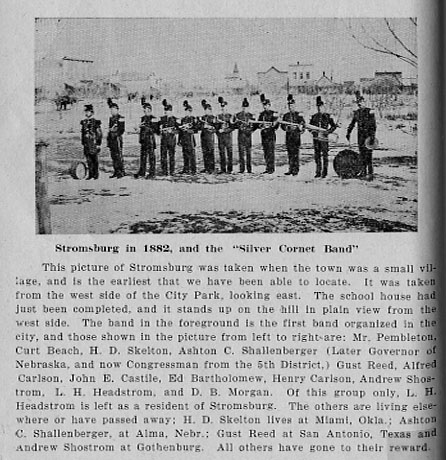
The dawning of the year 1891 was probably as cold as any January can be, but that did not deter the Stromsburg Silver Cornet band from gathering at the depot to play a salute to Captain C. C. Eroe and Stromsburg Company I of the Nebraska National Guard as they departed for "the front." This is their official title although they would no doubt resemble the State Militias of the Civil War era more closely than today's Guard. Company I had their own meeting hall and uniforms, held regular meetings and drills and participated in statewide manuevers.
Local anxieties must have been raised when, as reported on January 8, a special train came back through Stromsburg carrying twenty-one wounded soldiers, "going to Fort Riley, Kansas, where they can have good hospital treatment." Not only did Stromsburg have its early version of the National Guard, but even the college later organized a uniformed company of its own recruits. Would that have been an early version of R.O.T.C.?
A local merchant took out a large ad, somewhat tongue-in-cheek, announcing that since the Army had deserted the town, shoppers had better act quickly before the Indians came!
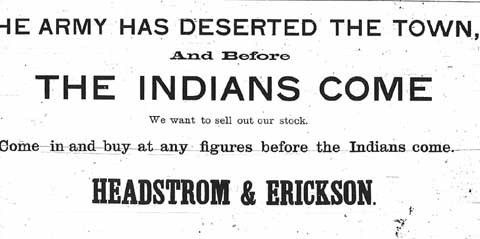
By the issue of January 22nd the thirty-some troopers are back in town, their return again saluted by the Silver Cornets and Captain Eroe displays a bloody "ghost shirt" complete with bullet holes as a trophy of battle. A further report notes that "The army passed through here on their way home Saturday and stopped at Shelby for a drink." (both Stromsburg and Osceola had voted "dry" at various times early on)
The Headlight is effusive in its praise of the citizen soldiers. But rumors of thousands of hostiles holed up in the Badlands had been exaggerated. The conflict had been quickly resolved, except to history. Company I had been dispatched to infamous Wounded Knee.
-Dalakarl
.......................................
In the fall of 1886 the railroad announced that it will "cut back seventy-five feet of the bank" and will move the expanded depot to the north side of the tracks. This is the first we knew that the depot had been on the south side or that there was that much embankment on the north.
Railroading is a little out of our usual subject matter, but the railroads had a big part in Stromsburg history. Besides, there's a little "railfan" in all of us; the line through here has always been known as the "Stromsburg Branch" and there is even a book about it by that title. The Headlight frequently mentions train crewmen by name and they were well known to people of the town.

According to the book by Jim Reisdorf and Forrest Bahm, the Omaha and Republican Valley railroad reached Stromsburg in 1879 and this would be as far as it went till 1906 when it was extended to Central City. The Kansas City and Omaha railroad reached Stromsburg from the south in 1886-7. Union Pacific controlled O&RV and the Burlington controlled KC&O; later both would take over these subsidiaries.
In June of 1888 the railroad announced that the roundhouse at Valley, Nebraska, would be moved to Stromsburg. Early maps show terminals for both lines east and west of the highway and a roundhouse on the U.P. side. The book says both roundhouse and depot were shared. Regular newspaper timetables appear for a "St. Joseph and Grand Island railroad (Union Pacific Route)" which apparently traversed the Burlington tracks. Then, in September of 1991, the roundhouse is moved to Beatrice and a new and bigger turntable is built.
Maybe like me, you think of car headlights when reading The Headlight newspaper. That would be wrong, since cars weren't around yet. In fact the banner for the newspaper in those days featured a locomotive coming down the tracks...with its headlight shining!
-Dalakarl
...................................
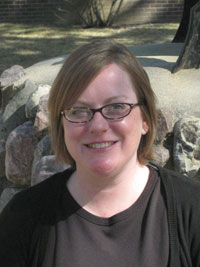
"I chose Nebraska because I wanted to honor my ancestors who emigrated there in the late 1800's and early 1900's. According to family lore, my ancestors wanted the future generations of their family to have more than a dugout and a homestead, which were the places in which they began their lives in Nebraska, and a hard life of farming. It seemed fitting that I, the first female in my family working toward a doctorate, should return to Nebraska to honor their desires.
Participants with ties to the three Nebraskan counties in which my ancestors lived were selected to participate in my study. While I collected data from January-August 2010, I visited my ancestors' old homesteads just so that I could feel the ground -- their ground -- underneath my feet and see the hills they looked out upon. The smell, the air, the wind, the sun, and the ground -- rich with rhizomatic roots -- joined with a sense of my personal history, helped me to think differently about my life and work."
This is made more special by the fact that one of the counties Susan mentions is Polk, and another Knox, home to Dalakarl. The professional rules prevented her from identifying just who in Polk County she interviewed, but I can tell you that if you ask anyone in the genealogy group in town they will be eager to share more about the interviews. Her published dissertation is available at the Stromsburg library. Hopefully she will write more for a popular audience in the future since the French philosophy in the dissertation may be heavy going for some.
Susan uses the example of "rhizomatic roots" mentioned above to illustrate how intertwined our immigrant families and communities are, just beneath the surface. That is certainly true, and the reason a little genealogical digging can be so rewarding. And now for the most special thing of all: Dr. Susan Nordstrom, now of the faculty of Wayne State College at Wayne Nebraska, is the great-great granddaughter of Anders and Charlotta Greenwall, my own great-grandparents.
-A proud Dalakarl
..........................................
There was a real sense of excitement in the July 18, 1889 edition of the Headlight, captured in the following announcement:
"Professor P. Waldenstrom is advertised to be in Stromsburg, August first. He will draw a great crowd, and is supposed to have a big tent and thousands will come to see Sweden's greatest man of the present day. He is a member of the Swedish congress, professor of the university, and the leading clergyman, and the Swedish-Americans everywhere will do him honor. There will be a crowd in town that day."
Though there may be some journalistic exaggeration in the note above, it remains remarkable that Waldenstrom would come way out to the plains of Nebraska and to Stromsburg. We intend to highlight stories from his visit, and a subsequent visit in 1899, but perhaps an introduction to this man is in order.
The great changes in Sweden's society in the 19th century have been described in various ways. There was a rising up of the lower class and pressure against the established order of nobility and landowners due to the dramatic increase in population among the peasants, their oppressive poverty and the fact that more and more they were becoming literate.
Since the Swedish state church was firmly in the hands of the nobility it was predictable that religious change was part of this movement. Swedish lay leaders and some sympathetic clergy of the state church formed new organizations which became widespread. Among these were the Swedish Baptists and Mission Friends. Waldenstrom was one of these sympathetic state church clergymen, and when he conducted a communion service for one of these groups, he was censured.
Though somewhat reluctant, he became the leader of the "separatists" and first president of the Missionsforbundet, or Mission Covenant of Sweden. The American Covenant was founded on similar principles a few years later. In one of his writings, he questioned whether the venerable Anselmian doctrine of the Atonement was really Scriptural. This issue was hotly debated by the Swedish clergy and spilled over into America as well. The Augustana Lutheran leaders here strongly disputed Waldenstrom's position and quite a number of their members went over to the Covenant.
In Stromsburg, the issue was even raised in the Swedish Baptist church when Central Bible Seminary head J.A. Edgren accused the pastor, A.P. Ekman, of holding the errant view of the Atonement. Eventually the dispute was resolved. In America, both the members of the Covenant and the Swedish Free Mission churches were generally known as "Waldenstromians." A picture of him addressing a crowd outside the Stromsburg Mission church is below.

-Dalakarl
.........................................
There were woods in the park area, just not as dense as today. If the college had remained but a few more years, our imaginary window view could have included the summer camp meetings sponsored by the Swedish Methodists just south of the park. That campground, long abandoned and overgrown, remains untouched and undeveloped from those early days. Here are some remeniscences:
"During the years between 1905 until some time in the early 1920's the church sponsored and held each year what was called "Camp Meeting" in a grove along the Blue River about a mile south of Stromsburg. These meetings were held after harvest in the late summer and lasted for about two weeks. The meetings were held in a large tent with meetings for the children in the mornings and adult meetings in the afternoons and evenings. The local minister was in charge of services assisted by ministers from other Swedish churches and by local lay members.
Some church members put up small tents and slept on the camp grounds, and there was a permanent dining hall building on the grounds where noon and evening meals were served during the meetings. Church members donated meats, vegetables, milk, eggs and other farm products which the women of the church cooked and served. These meetings were well attended. They not only provided inspiring worship experiences, but gave the opportunity for fellowship in visiting with those who came from other Swedish churches and other communities." (1976 Swede Plain Centennial book)

An insight into the camp meetings held frequently and at various locations is the value placed on the "concessions" present at these events. The following notice in the Headlight concerns the August, 1889, meeting of the "Saints of God" at Hoffer's Grove, one mile south and four east:
"No huxtering or the selling of cigars, tobacco, lemonade and eatables or any other thing not mentioned on or near the grounds than the law permits, only as permitted by myself -William N. Smith." Apparently these concessions played a part in the camp meeting economy. The sponsorship of the Stromsburg Camp grounds passed from the Swede Plain people to the State Epworth League, Methodist youth, in its later years.
-Dalakarl
...............................................
Perhaps the most memorable image of our region which appears in this book is an illustration, a line drawing showing the pride of the midwest, a cornfield. The striking thing about this cornfield is that it looks nothing like any cornfield any of us natives have ever seen, even in 2012! In this picture the corn stands fifteen feet tall, and a couple is walking serenely down a pathway winding between these giant rows as through a woodland!
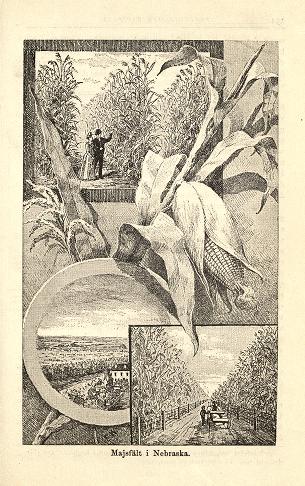
This inaccuracy highlights some of the exaggeration that went on when America was represented to the folks back in Sweden. This served the purposes of the immigration land agents very well, and indeed Waldenström's visit was sponsored and shepherded by such men as Leander Hallgren, a railroad land agent promoting Nebraska colonization. They made sure he visited the impressive places in America; Niagra Falls, the Rocky Mountains, etc., and he was duly impressed.
But Waldenström was not a naive observer. His book reveals that Americans sometimes impressed him as boastful and bombastic. In fact, he describes the typical midwestern village as "ful;" that is, foul, dusty, muddy unpleasant places. The early pictures of our towns are surely a contrast with the neat, tree-lined places we know today. Quite a contrast with the tidy Swedish "stads."
What seemed to delight Waldenström most was to encounter someone in America from his homeland region in northern Sweden; the Gävle area. This happened in Stromsburg, and he describes the meeting as one of tearful joy and recognition. Think how remarkable this would be, to find countrymen with the same accent and dialect in a far-away American enclave. This helps us understand what governed the hearts and minds of the immigrants; why they clustered together in communities as they did. This is how places like "the Swede Capital" were born.
-Dalakarl
.........................................
Much of our Swedish heritage is preserved in our distinctive last names. We know that having a "last name" was not common up till the 1800's in Sweden except among the nobility. So, John whose father's name was John would be known as "John John's-son." And there were a lot of them. But many others did not take this kind of last name when they became permanent. The most common other type of last name was made up of words from the world of nature; plants, landscapes, bodies of water or even animals. Another type were the "martial" names taken when young men entered the military. Here are some examples of both:
Rev. Lundgren, the carpenter who was preacher at Swede Home, Stromsburg Baptist, and is even listed among the early preachers of the Mission Church, had a name made up of the elements "grove" (lund) and "branch" (gren). It is not impossible that the "e" had been substituted for "ö" which does not exist in English and that would have been "green" (grön) meaning "green grove" which makes more sense than "grove branch."
The last name of Rev. L.P. Ahlquist, pastor at Swede Home, who is also listed among Stromsburg Mission preachers, is taken from the alder tree (al) and twig, or shoot (quist). Every possible tree appears in this name formula: Granquist (Norway spruce), Enquist (juniper), Lindquist (linden tree), Palmquist, etc. Or, Quist could appear alone, as in Mission pastor John Quist of the 1890's. Or the tree itself, as in Rev. Palm of the Baptists, or the name "Lind."
Rev. C.A. Falk's name could cover both nature and martial categories, since it is a bird but a bird associated with the military; falconers. Pastor Bob Johnson pointed out to me that our mutual friend named Mars had one of the military type; Mars, god of war. We also have a friend named Spjut (spear). Stromsburg knows the names Sward (sword) and Stark (strong); others are Pihl (arrow), Hjelm (helmet), Pamp (cannon), Modig (brave) or Bowman (as in longbow).
Falk was pastor of the Mission church, and you notice that several others from different denominations had also preached there. Evidently the Mission Church intended to be open to the full variety of perspectives! They even called a Swedish Congregationalist, but he had a more ordinary name; Peterson.
These colorful names, so familiar to us, must have seemed a bit strange on the American scene. But perhaps not so much to the native Americans. How about "röd moln" (Chief Red Cloud)? We'll save the waterways for another time (ström = stream etc).
-Dalakarl
.........................................
In 1897 Rev. John Quist is given a farewell by the Mission Church. His long ministry began in 1891 so his name appears often in the Headlights of that decade. The congregation gave him a gift of $50 in appreciation, and the "York congregation" another $10.
Stromsburg is well known as the Swede Capital of Nebraska. York is not. What about these Swedes? If it were not for hints such as this one, and a brief account of the rural Bethesda Church in Sandahl's history, they might be completely forgotten.
Evidently Quist had been ministering to this group, probably on Sunday afternoons since his primary responsibility was to Stromsburg, and Rev. C.A. Falk's preaching trips to York are mentioned frequently in the paper as are trips he made to numerous other places. Since this group had no church building, they would have been considered a "preaching station" and would have met in the local school house.
John Peterson writes in his 125th History that Mission churches and preaching stations in Nebraska totaled seventy! York is one of thirteen that he names. One wonders if any records survive from York or any of the others. By the 1920's nearly all the preaching stations were gone; a few which built churches had only short lives.
We learn more from the Augustana history of C. F. Sandahl, including a picture of the Bethesda Church building and its general location northwest of York. It also relied on ministers shared with Stromsburg; Rev. G. Peters and O.A. Johnson. The Sandall brothers (different spelling) and others came to York county together from the New Sweden and Swedesburg area of southeast Iowa. This was the same area that contributed a group to the Stromsburg Baptists.
Sandahl reports that the York Swedish community was visited by "another denomination" meeting in a school house, but that the Augustana minister scheduled services at the same time to prevent his members being drawn away... Bethesda was a small group relying on assistance from the Conference to survive, and ultimately joined with the York American Lutherans.
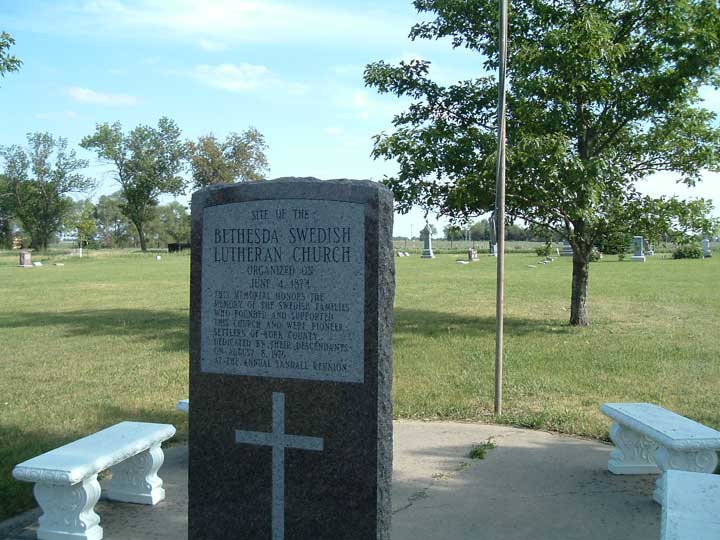
Friends joined us on a recent Sunday afternoon quest to find the site of Bethesda. As in so many of these more remote Swedish settlements, the cemetery remains the permanent location by which to find just where they were. We did not know what to expect "northwest of York," and were quite surprised to find that Bethesda Cemetery and church site are right on highway 34, about three miles west of the airport! There is a marker on the well-kept grounds, with many a Swedish inscription on the gravestones of the Sandalls and others. We had found the York Swedes!
-Dalakarl
....................................